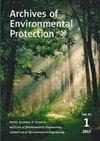Mercury content in refuse-derived fuels
IF 1.3
4区 环境科学与生态学
Q4 ENVIRONMENTAL SCIENCES
引用次数: 4
Abstract
is a non--pro fi t association, founded in 2001 by European companies producing recovered fuels. ERFO was established to develop the concept of Solid Recovered Fuel (SRF). SRFs are solid fuels prepared from non-hazardous waste to be utilized for energy recovery in incineration or co-incineration plants and meeting the classi fi cation and speci fi cation requirements laid down in the EN15359 European standard. ERFO’s main aim is to promote the production and use of recovered fuels, and especially SRF, in Europe. To that aim, ERFO supports standardization of SRF and participates in research projects. Abstract: The paper presents the results of testing the mercury content in fuels derived from different types of waste. Legal and technical issues related to preventing mercury from getting into the environment are taken into account with respect to refuse-derived fuels used in cement plants. The mercury content in refuse-derived fuels is usually smaller compared to conventional fossil fuels such as coal. For this reason, the requirement imposed on the fuel suppliers that it must not exceed the limit of 0.3 ppm (in dry matter (DM)) seems over-restrictive and unjusti fi ed. The paper presents the sources of mercury contamination of waste with attention drawn to the signi fi cance of selective waste collection and the need to educate the public in this area. Presented are results of the testing of the mercury content in waste types characterized by a great variation of the parameter depending on the origin of the waste combustible垃圾衍生燃料中的汞含量
是一个非营利性协会,由生产再生燃料的欧洲公司于2001年成立。ERFO的成立是为了发展固体回收燃料(SRF)的概念。srf是由无害废物制备的固体燃料,用于焚烧或共焚烧厂的能量回收,符合EN15359欧洲标准中规定的分类和规格要求。ERFO的主要目标是促进欧洲回收燃料的生产和使用,特别是SRF。为此,ERFO支持SRF的标准化并参与研究项目。摘要:本文介绍了不同类型废弃物燃料中汞含量的检测结果。就水泥厂使用的垃圾衍生燃料而言,考虑到与防止汞进入环境有关的法律和技术问题。与煤炭等传统化石燃料相比,垃圾衍生燃料中的汞含量通常较低。因此,对燃料供应商施加的不得超过0.3 ppm(干物质)限制的要求似乎过于严格和不合理。本文介绍了废物中汞污染的来源,并注意到选择性废物收集的重要性以及在这方面教育公众的必要性。本文介绍了对各种废物中汞含量的测试结果,这些废物的参数根据可燃废物的来源而有很大变化
本文章由计算机程序翻译,如有差异,请以英文原文为准。
求助全文
约1分钟内获得全文
求助全文
来源期刊

Archives of Environmental Protection
ENVIRONMENTAL SCIENCES-
CiteScore
2.70
自引率
26.70%
发文量
0
期刊介绍:
Archives of Environmental Protection is the oldest Polish scientific journal of international scope that publishes articles on engineering and environmental protection. The quarterly has been published by the Institute of Environmental Engineering, Polish Academy of Sciences since 1975. The journal has served as a forum for the exchange of views and ideas among scientists. It has become part of scientific life in Poland and abroad. The quarterly publishes the results of research and scientific inquiries by best specialists hereby becoming an important pillar of science. The journal facilitates better understanding of environmental risks to humans and ecosystems and it also shows the methods for their analysis as well as trends in the search of effective solutions to minimize these risks.
 求助内容:
求助内容: 应助结果提醒方式:
应助结果提醒方式:


